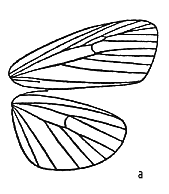|
Hesudra
Moore Gen. rev.
Type
species: divisa Moore, India.
This
and the next genus have been subsumed in the past under Agylla Walker (type species fasciculata
Walker, Venezuela). Agylla is a
strictly Neotropical genus, with features such as tufts of androconia on the
male forewing and hindwing, and broad, undivided valves with central hook-like
structures in the male genitalia that are not shared by any Oriental taxa (one
feature that is shared is the presence of an areole in the forewing venation);
the genus is being revised by N. Jacobson (in prep). There are several
genus-group names available for the Oriental fauna, most of which have already
been resurrected by Kishida (1993, 1994), such as Vamuna Moore (see Vamuna Moore), Churinga
Moore (type species rufifrons Moore,
India), Ghoria Moore (type species albocinerea
Moore, India) and Sidyma Walker
(type species albifinis Walker, India;
Fig 1a), and the last, Tripura Moore
(type species prasena Moore, India),
placed by him as a synonym of Macrobrochis
Herrich-Sch�ffer (see Macrobrochis
Herrich-Sch�ffer).

Fig 1a: Sidyma
albifinis Walker
Hesudra
species are
typically robust, with Eilema-like facies
and bipectinate male antennae. The forewing is typically divided obliquely into
costal pale and dorsal grey halves. The dorsum of the male hindwing is also
folded under and clad in thicker scales in more typical members of the genus.
The
male genitalia typically have a rather deep dorsal portion to the valve that
bears a comb of inturned spines basally on its costal margin or on a produced
lobe. The saccus encloses a tuft of hairs, and the aedeagus vesica has one or
two dense groups of spines.
The
female genitalia (divisa) have a cleft
sterigma, a short ductus, and an elongate bursa divided into two by a central
constriction. Both halves of the bursa are scobinate, but the distal half
contains a large elliptical signum consisting of spines on each side directed
away from a central groove.
The
genus Ghoria Moore has
somewhat similar facies but the white areas are glossier and the male genitalic
features just described are absent except for the aedeagus vesica ornamentation;
the female has a similar signum but it forms a more elongate band longitudinally
in the bursa. The Sumatran taxon dirhabdus Rothschild is a Ghoria.
Hesudra appears to contain only the species referred to. (see
Hesudra divisa Moore comb. rev, Hesudra
bisecta Rothschild comb.n,
Hesudra mjobergi
Talbot comb.n)
<<Back
>>Forward <<Return
to Contents page
|

